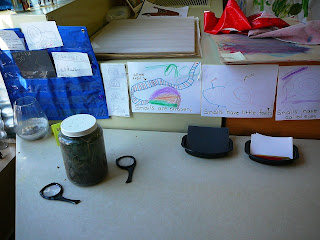Whenever we had guests over for supper when I was a child, my mother would always worry that she did not have enough food. Despite decades of experience in cooking ‘for company,’ she still has that worry today. And we have never run out! I am reminded of that as my partner and I review all our assessment information to write an evaluative final report card. We feel like we just wrote the last one yesterday in some ways, and worry we won’t have enough “food” to share!
The Theory:
Young
children show their understanding by doing, showing, and telling. Early Learning–Kindergarten
teams need to use assessment strategies of observing, listening,
and asking probing questions in order to assess and evaluate children’s achievement. (FDELK
Draft Program, p. 28)
Observation,
as well as the documentation of observations, is the most important method for
gaining assessment information about a young child as he or she works and
interacts in the classroom.
Observation should be the primary assessment strategy used in the early learning
program. (FDELK
Draft Program, p. 30)
Reporting
should reflect achievement in the skills and strategies that the children are
developing as they progress through the program. (FDELK
Draft Program, p. 32)
The Practical:
Working in an inquiry stance with students,
where there isn’t generally one experience, representation, observation… that all
did on a given topic as in the way we planned those ‘theme’ experiences in the
past, we worry that maybe we ‘fed’ some too little. So at this time of year,
when we really look at the sum total of what we know about ‘this student’s
development in relation to…’ we were gratified to learn that all that
documentation of their thinking was plenty of food. Taking the Science strand as an example, we
had many quotations of their thinking, their own drawn and written
representations, photos of the learning in action… all in a variety of
different experiences all over the classroom and in our notes.
This year we worked toward building methods of observation and making the childrens' thinking visible in the classroom. That will continue to be the journey. My learning as I write the report cards is to add a deeper layer of reflection on this. To take the bird’s eye view of our assessment
information more often, maybe once a month next year. In looking at Science as
an example, I notice that some students are more drawn to this strand, just as some
are more drawn to visual arts, and note that we need to continue to invite and
look for interests, questions and opportunities to provoke the engagement of
those who gravitate more to other areas (and bring the ‘science inquiry stance’
there). Some students were more drawn to nature and environmental explorations
(e.g. the snails that were carted in),
some to ‘substance’ exploration (e.g.
cornstarch goop), some to investigations (e.g. the ‘wheels’ experiments),
some to ‘curiosity’
explorations (e.g. an individual
Dollarama egg poacher put with a large paper to record thoughts about “What can
this be used for?”), some to ‘design’ explorations (e.g. constructing a car; taking
apart a real telephone), etc…
The ‘bird’s eye view,’ let us see that pattern of
interests a little more clearly which of course becomes another stepping stone
towards planning.
In conclusion, this report card is really bringing clarity
to the value of our observations, the value of taking time to discuss those
observations. For example, standing back and looking at a documentation panel together and
asking ourselves, “What is this telling us about what they know, strengths,
interests, next and future steps?”
Now I really must get back to that report card writing… although this
has been a worthwhile reflection… it has also been a procrastination LOL!


